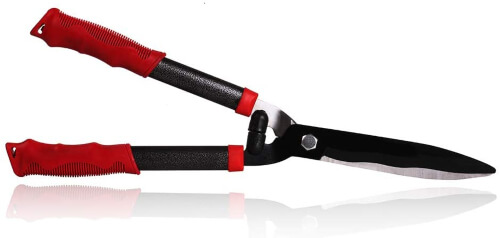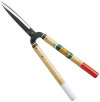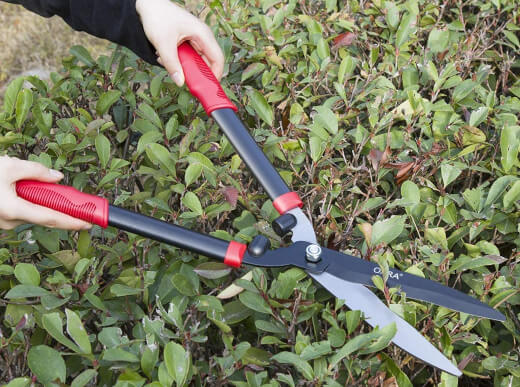Hedge shears, also called garden shears, make it easy to keep ornamental trees, shrubs and hedges in shape and trimmed to perfection.
Most shrubs need trimming at some point so as to stop them from absolutely taking over every other plant in your garden (if they are healthy) and the best cheaper tool for the job is hedge shears.
More...
Top Pick


Best Value


Premium Choice


Best Hedge Shears for 2024
Product | Our Rating | Price | |
|---|---|---|---|
1. ARS HS-KR1000 Professional Hedge Shears |  |  | |
2. Oara Garden Hedge Shears |  | ||
3. Okatsune Precision Hedge Shears |  |  | |
4. Corona HS3244 ComfortGEL Hedge Shear |
Hedge Shears Buying Guide
I’ve put together a list of the best hedge shears on the market as well as tips and advice on these tools to help you find a product that works well, is durable and has all the features needed to make gardening simple.
What are Hedge Shears Used For?

Hedge shears are handy tools that have been crafted for specific gardening tasks that involve cutting soft, non-woody stems and branches, including:
- Trimming formal hedges – This is the most obvious use for these shears, as it’s right there in the name! They can be used to cut off new, bushy growth as well as create clean lines and shapes for formal hedging and topiary.
- Pruning perennials – In order to get healthy new growth and a great crop of flowers, most perennials like bougainvillea, lavender, salvia, coneflower and delphiniums benefit from a pruning in late winter.
- Maintenance and deadheading – Hedge shears can also be used to deadhead plants to encourage vigorous, multiple flowering.
What to Look for in the Best Hedge Shears
- A sharp, high quality blade - It is hard to test this without feeling the blade but you can get a rough idea of its sharpness by gently touching the blade.
It should not feel smooth, if it feels smooth then it is already slightly flat and won’t get better with use. The best blades are carbon-steel, as this offers sharpness, durability and strength. - Curved blades – This shape helps to stop branches slipping down the blade as you cut, giving you better results and cleaner cuts.
- Strong handles - I myself prefer wooden handles simply because I know they are strong. However, if you want a lighter tool, try and find a hedge trimmer with handles made of carbon fibre.
Stay away from aluminium handles because they bend more easily when force is applied.
- Non-stick coating – Blades with non-stick coating make cleaning your shears much easier when they get covered in sap.
- Adjustable pivot-bolt assembly – This is a great extra feature to look for that allows you to adjust the blade tension yourself. Pivot bolts are usually the first part of a hedge shear to get damaged, so it also makes it easy to replace the part without having to buy new garden shears.
- Gear reduction – Trimming hedges is tough, repetitive work that can quickly cause strain and muscle fatigue. Geared technology in the cutting mechanism helps take some of the effort out of this task, making it easier on your hands and shoulders to do more extensive jobs.
Different Types of Hedge Shears

There are slightly different types of hedge clippers for different trimming jobs.
- Short blade – Short-bladed shears (15cm blades) are best-suited to close-up work on delicate topiary or pruning/deadheading perennials.
- Long blade – Shears with longer blades (up to 30 cm) are better-suited to bigger projects like trimming a large boundary hedge. The bigger blades make the job a lot faster.
How Much Do the Best Hedge Shears Cost?
As with most gardening equipment, there are a lot of inferior-quality tools on the market that seem like a good deal but end up costing you a lot more in the long run when you have to replace them each year!
A ‘cheap’ pair of sturdy hedge shears will set you back at least $20, if you’re paying less you are probably buying the cheapest or next to cheapest tool. An expensive pair of shears will be in excess of $100.
A good range is probably the $40-$50 cost range. Very rarely will you buy a tool for that price that isn’t great value. If you are running a gardening business you may well like to consider buying a more expensive model designed for high use.
How to Use Hedge Shears to Trim a Hedge
These garden shears are specifically made for precision cutting of hedge foliage and soft, new growth. Here are some guidelines for using your shears correctly.
- Know when to trim – Non-flowering hedges should be trimmed every 6-8 weeks in the growing season and once every two months in cool seasons.
Flowering hedges should be trimmed after they bloom or in late winter so you don’t cut off any flowering growth. - Run guide strings – Set up stings at the top, bottom, and sides of the hedge to guide your cuts and keep your trimming level. Use stakes to set the strings and make sure the strings are taut.
- Trim top down – Start by trimming the top of the hedge, holding the hedge shears as level as possible. If you are using a ladder, position it into the hedge so that you can lean over the hedge without toppling it.
- Square up – Use the same method to trim the sides and ends of the hedge, working from the top down.
- 3-year rule – If your hedge is old and overgrown, you can stimulate new growth by following the 3-year rule. Simply use a pruning tool to remove about one-third of the thickest stems at the base of the plant.
This should be repeated for 3 years. This will encourage the plant to grow from the base.
How to Care For and Maintain Your Hedge Shears
- Cleaning - To best care for your garden shears, wipe them off with a rag of warm, soapy water after use. This helps to clean off sap from the blades and remove gunk that is likely to cause your tool to rust.
- Sharpening - Check the blades to ensure that they are sharp and secure in the handle. Sharpen once a season before use and replace the blades as needed.
- Store – Pack away your garden shears somewhere dry, out of the sunlight and out of reach of children, in your garage or garden shed. Do not store with the blade resting on the floor, as this can blunt the tool or cause it to fall over. Secured on the wall is best.
Hedge Clippers Safety Tips
- Protective clothing – Wear a long-sleeved top and pants, thick gardening gloves and sturdy, closed shoes.
- Position – Stand close to the plant you are cutting to give you control over your cut. Make sure your feet are in a sturdy, secure position, especially if you are on a ladder.
- Blade awareness – Hedge shears are pretty safe gardening tools but they still have a very sharp, pointed blade. Keep young children and pets out of the area where you are working, always place your shears carefully and out of reach of children, and where they cannot fall over, be tripped over or stood on.
Hedge Shears Reviews for 2024
1. ARS HS-KR1000 Professional Hedge Shears
ARS HS-KR1000 Professional Hedge Shears have long lasting sharpness and a pivot bolt for blade adjustments.
Created with superior steel and blade treatment, you get an unsurpassed cutting performance.
In addition to it's perfect shape and balance, professionals tend to choose this hedge shears because to it's superior durability.


Get Your Free Guide:
Master Growing Australian Natives eBook
A Must Have Complete Guide for Every Australian Garden
Get Your Free Guide:
Master Growing Australian Natives eBook
A Must Have Complete Guide for Every Australian Garden

Source: Amazon
2. Oara Garden Hedge Shears
Oara Garden Hedge Shears is made out of high quality 65 MN carbon steel making it ideal for shaping and manicuring boxwood, hedges, shrubs and decorative topiary plants.
It is coated with Teflon that prevents rusts, corrosion, and corrosion. It also reduces clinging of dirt which helps maintaining it easy and convenient.

Source: Amazon
3. Okatsune Precision Hedge Shears
With Okatsune Precision Hedge Shears, you'd feel like a Japanese Swordsman in your garden. Why?
Because this hedge shears are made of Izumo Steel blades, the same blade material used in Japanese Swords.
These short garden shears are used by professional gardeners throughout Japan.
The handles are strong but light and less have less vibration thanks to its Japanese Oak handles.

Source: Amazon
4. Corona HS3244 ComfortGEL Hedge Shear
Corona HS3244 ComfortGEL Hedge Shear is built with intergrated shock-guard bumpers reducing strain and fatigue to your arms and shoulders.
It has ergonomically shaped grips for maximum comfort, fit and control.
And, with it's specially coated non-stick blades that helps with maintaining it's sharpness, you will surely have a blade that will last long.

Source: Amazon
Best Hedge Shears Australia
Top Rated Best Hedge Shears for 2024


Our top pick as the best hedge shears for 2024 are the ARS HS-KR1000 Professional Hedge Shears! With superior steel construction for durability and long-lasting sharpness, these hedge shears are a favourite for professionals and gardeners alike.
The replaceable blades make it easy to maintain and the pivot bolt allows you to customise your blade adjustment for different tasks.
Cutting with these high quality blades and ergonomic handle is like a knife sliding through butter, making hedge and shrub maintenance a breeze!
Best Value Hedge Shears


With a good mixture of quality and affordability, the Oara Garden Hedge Shears are our pick for the best value hedge shears. With high quality 65MN carbon steel blades and ergonomically-designed handles, it’s easy to trim hedges, topiary and decorative plants.
The blade is also coated with Teflon to make it more rust-resistant, corrosion-resistant, and easy to clean. With shorter handles and shock-absorbing bumpers, it’s easy to work for longer without fatigue and cut with precision in tight spaces.
Premium Choice Hedge Shears


If you want to spend a little more and get a premium pair of hedge shears, we recommend the Okatsune Precision Hedge Shears. They’re priced a bit higher than competitors, but have a lot to offer, from a comfortable handle to precision, high-quality blades.
The shears are easy to maintain and clean, and the blades are as sharp as Japanese samurai swords, making them a joy to use.
Hedge Shears Frequently Asked Questions
What is the best use of hedge shears?
As the name suggests, the best use of hedge shears is cutting hedges, but how you use them will really impact the overall finish. Use hedge shears to create neat lines and crisp edges.
They are far better for formal hedging than informal or wildlife hedges, where the aim is to create a bushier finish.
What tools are used for cutting hedges?
You can cut hedges with anything and everything, from electric or petrol-powered hedge trimmers and manual hedge shears to hand secateurs or even chainsaws. The best tool for the job is traditional hedge shear though, ideally with a freshly sharpened blade and good tension between the blades for faster results.
How much can hedge shears cut?
Hedge shears are perfect for cutting back the annual growth of formal hedges, but not particularly useful for much else. In terms of branch thickness, 1.5cm is about the thickest branch they can tackle without extra effort.
When should you not cut hedges?
Avoid cutting hedges in rainy weather, or just after heavy rain. The moisture can quickly gum up your shears, which causes tears in the branch, rather than clean cuts.
Torn branches will incubate fungal spores or bacteria and may harm your hedge, so you shouldn’t cut hedges while they are wet.
What time of year should you cut hedges?
In terms of hedge health, you can cut a hedge at any time of year, but different plants have different needs. As a general rule, the best time of year to cut your hedge is in late winter and early autumn.
Each will have opposite effects, where the autumn prune will stunt growth to maintain shape, and the winter prune will promote fresh green shoots or flowers.
What time of year should you not cut hedges?
Hedges are great nesting sites for birds so should not cut hedges in spring or summer. A gentle hand trim using secateurs can be done safely without harming wildlife (if, for example, there are signs of disease that need removing), but otherwise, avoid cutting hedges during the nesting season.
How do you cut a hedge for beginners?
If you’ve never cut a hedge before, it’s important to have some confidence, and remember that your hedge will grow back and that no damage is permanent. Try to keep your shears level with the body of the hedge to create straight lines.
What is the best way to cut a hedge?
While most hedges you see around Australia are pruned into pretty uniform boxes, the best way to cut a hedge is actually to create angles at the top.
Cut the sides of your hedge neatly first, and then cut a 10-20 degree angle all the way across the top, so the shaded side is lower than the sunny side, allowing more light to pass into the garden, and allowing you a better view of the top of the hedge.
Why do hedge shears have a wavy blade?
The wavy blades on hedge shears serve a very simple purpose: friction. When you’re cutting, waved blades prevent branches from springing or sliding out of the shears, gripping them for better cuts, without missing frilly bits with each cut.
Can hedge shears cut small branches?
If you’re in a bind and short of secateurs, hedge shears can be used to cut small branches, but only very young growth that is a maximum of 1.5cm thick. Any thicker and you’ll tear the branch, or put too much stress on the hedge shears.
How do you cut a hedge straight?
The best way to cut your hedge straight, and maintain its height over the years, is to set up a string line. It might sound old-fashioned, but there’s really no better way.
Just secure some bamboo stakes to the hedge, or tie a string to the right height of your hedge, and follow the line for the entire length. Check the tension regularly so you don’t get dips, and make sure you don’t cut the string!
Do you cut the top or sides of a hedge first?
Always start by cutting the side of your hedge, and working from the bottom up. Our instincts when working top down will always create an A-shape. Working from the bottom up creates a better angle, and means the falling branches don’t get in the way of lower-down cuts.
Find more in-depth reviews for different tools for pruning and trimming various types and sizes of plants below:

Get Right Hedge Shears Today
With good quality garden shears, you can express your creativity in topiary, grow a beautiful privacy hedge and prune your perennials with ease. Remember to buy a good quality tool with a durable, sharp blade and ergonomic handles, and to use and store it carefully to keep it in great shape.
The best hedge shears will last you a lifetime and make these important gardening tasks a breeze!
Published on January 22, 2023 by Aussie Green Thumb
Last Updated on October 10, 2024





I think your site is great but I have a question. I need to plant a 10 metre long hedge that will end up being dense and 4-5 metres high in tropical north Queensland. What species should I look for? Thank you.
Hey there Rosemary,
Thanks for the question.
The good news is that your location is great for hedging as many species thrive in tropical environments and like plenty of sun.
Your soil quality and density will also play a vital role in ensuring your hedge grows well. Planting in small, narrow areas like in between paved areas or driveways with poor soil can result in poor performance from your hedge. If needed, spending some time improving your soil will be well worth it. Lastly, it is also important to consider maintenance and the sun conditions on your property.
Here are a few suggestions for the best hedging species in your area.
Blueberry Ash (Elaeocarpus reticulatus)
This small tree makes for a good hedge for screening to fence height. It normally grows to be around 6 to 8 metres high which is a little larger than you want. However, its highly attractive and ornamental qualities may make it the right choice for you. These trees are indigenous to Queensland and only require maintenance every 3 to 4 months once established.
They bloom with bell-shaped flowers in spring followed by small blueberries. The most attractive feature of blueberry ash is its leaves. The foliage appears red with new growth and turns dark green as the tree grows. These trees love warm environments with full sun. Plant 1 metre apart for the best hedging results.
Our full growing guide for Blueberry Ash can be found here.
Lilly Pilly ‘Resilience’ (Syzygium australe)
All species in the Lilly Pilly family are excellent hedging plants but this species is specifically bred and propagated for hedging and features ideal branch growth all the way to ground level. This Aussie native grows to be around 4 metres high making it a good option for a suburban screening plant. Minimal maintenance is required for these hardy plants and the small, glossy green leaves look fantastic as part of a hedge. Planting 1 metre apart is also recommended.
For more information on how to grow and care for Lilly Pilly, you can refer to our helpful guide here.
Photinia Red Robin (Photinia fraseri)
This plant can stand out in a hedge thanks to its radiant-red new foliage that fades to bronze and eventually turns green as its growing season goes on. This species grows to be around 3 metres high and is fast-growing. It doesn’t require a lot of maintenance and can also look attractive when it’s left to get a little bushy.
Full sun is recommended for this plant but it can tolerate more shaded locations. Planted 1 metre apart is best for hedging purposes.
We hope this information proves useful for you. Happy hedging!
Gary Clarke